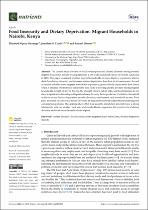| dc.contributor.author | Onyango, Elizabeth Opiyo | |
| dc.contributor.author | Crush, Jonathan S. | |
| dc.contributor.author | Owuor, Samuel | |
| dc.date.accessioned | 2023-04-24T10:42:32Z | |
| dc.date.available | 2023-04-24T10:42:32Z | |
| dc.date.issued | 2023 | |
| dc.identifier.citation | Onyango, E. O. et al. (2023). Food insecurity and dietary deprivation: Migrant households in Nairobi, Kenya. Nutrients, 15(5), 1215. 10.3390/nu15051215 | en_US |
| dc.identifier.issn | 2072-6643 | |
| dc.identifier.uri | 10.3390/nu15051215 | |
| dc.identifier.uri | http://hdl.handle.net/10566/8877 | |
| dc.description.abstract | The current study focuses on food consumption and dietary diversity among internal
migrant households in Kenya using data from a city-wide household survey of Nairobi conducted
in 2018. The paper examined whether migrant households are more likely to experience inferior
diets, low dietary diversity, and increased dietary deprivation than their local counterparts. Second,
it assesses whether some migrant households experience greater dietary deprivation than others.
Third, it analyses whether rural-urban links play a role in boosting dietary diversity among migrant
households. Length of stay in the city, the strength of rural-urban links, and food transfers do not
show a significant relationship with greater dietary diversity. Better predictors of whether a household
is able to escape dietary deprivation include education, employment, and household income. Food
price increases also decrease dietary diversity as migrant households adjust their purchasing and
consumption patterns. | en_US |
| dc.language.iso | en | en_US |
| dc.publisher | MDPI | en_US |
| dc.subject | Dietary | en_US |
| dc.subject | Diversity | en_US |
| dc.subject | Food security | en_US |
| dc.subject | Migration | en_US |
| dc.subject | Agriculture | en_US |
| dc.subject | Kenya | en_US |
| dc.title | Food insecurity and dietary deprivation: Migrant households in Nairobi, Kenya | en_US |
| dc.type | Article | en_US |

